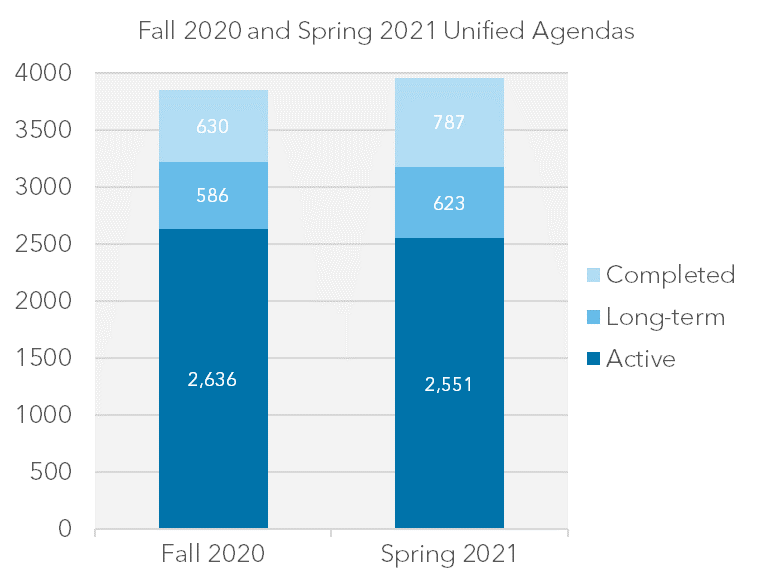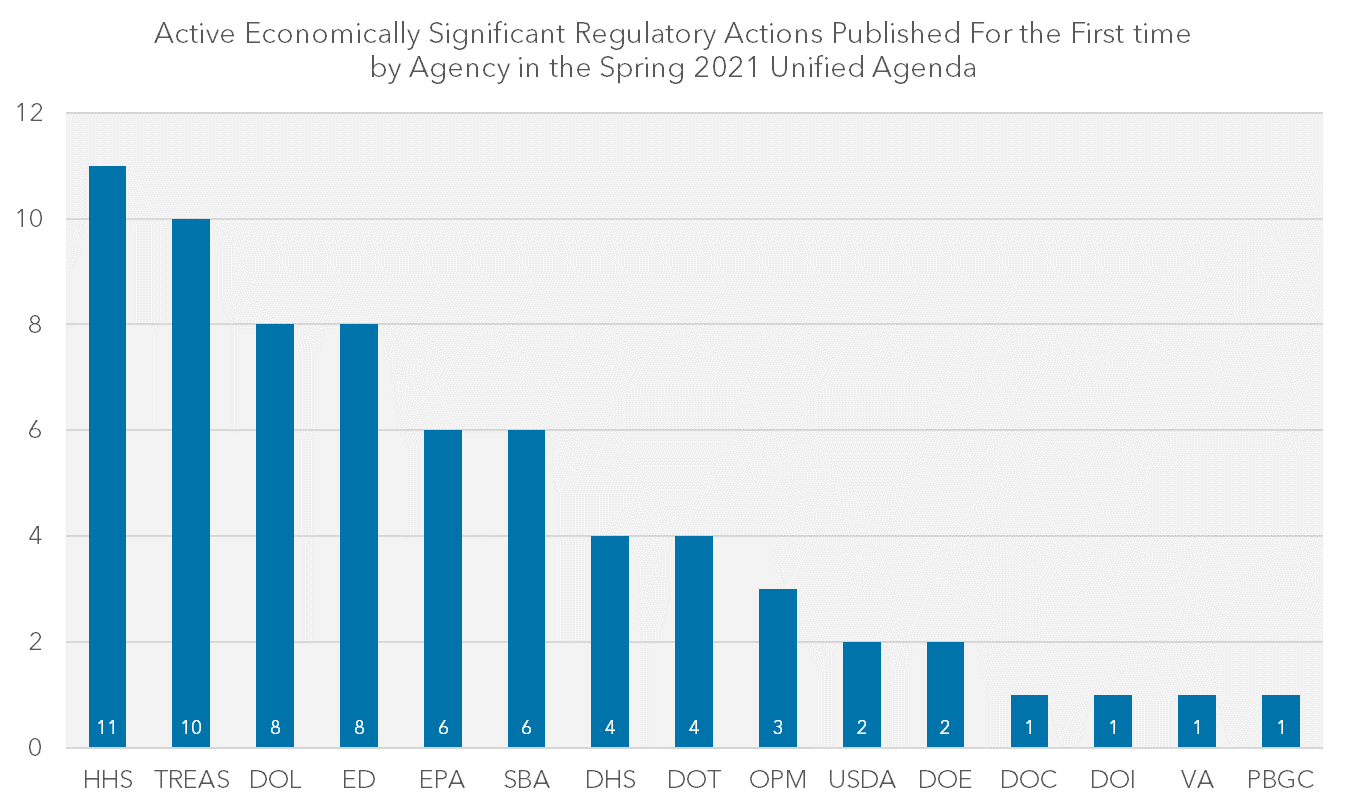Download this Commentary (PDF)
In brief...
The Office of Information and Regulatory Affairs (OIRA) released its semiannual Unified Agenda of Regulatory and Deregulatory Actions. This marks the first comprehensive look at the actions regulatory agencies are planning under the Biden Administration. The Agenda’s contents suggest that the administration’s priorities to date include withdrawing numerous proposed rules that were never finalized by the Trump administration and shifting regulatory policy approaches for higher education, immigration, labor, health, and the environment.
On Friday, the Office of Information and Regulatory Affairs (OIRA) released its semiannual Unified Agenda of Regulatory and Deregulatory Actions. The Unified Agenda provides an advanced look at all of the regulatory actions in development at federal agencies, and this is the first Agenda providing the public with a glimpse of the regulatory priorities of the Biden administration.
The entries in the Unified Agenda no longer classify actions as deregulatory or regulatory—consistent with President Biden’s day-one revocation of several Trump administration executive orders (EOs), including the two-for-one and regulatory budgeting EO 13771.
This Agenda suggests that higher education, immigration, labor, health, and the environment are high on the administration’s list for regulatory action. Unsurprisingly, President Biden has clearly expressed these policy priorities in various executive orders. Interestingly, some of these rulemakings cover areas where there has been considerable regulatory uncertainty since at least the Obama administration—such as the Department of Education’s Borrower Defense program, the Department of Labor’s definition of the term “fiduciary,” or the Department of Health and Human Services’ regulation of flavors in tobacco products.
What's In the Spring 2021 Agenda?
The Spring 2021 Unified Agenda contains a total of 3,961 agency actions—298 of which are economically significant.[1] These actions are divided by stage of development including: active (the next agency action is expected within 12 months), long-term (beyond 12 months), and completed actions (rules finalized or withdrawn since the previous Unified Agenda was published). Of the 2,551 actions listed as active, 611 (roughly 24%) are being published for the first time in the Spring 2021 Unified Agenda.
Of the 787 completed actions, 272 (about 35%) are withdrawals of proposed rules. Almost all of these withdrawals are the result of the Biden administration changing course on regulatory actions planned by the Trump administration. For example, President Biden issued an executive order on immigration policy that, among other things, revoked an EO issued by President Trump related to border security and immigration. As a result, the Department of Homeland Security withdrew several controversial proposed rules including the removal of its International Entrepreneur program, an expansion of the agency’s collection and use of biometric data, and a proposal to increase the stringency of regulations governing its affidavit of support requirements.
The volume of withdrawals is lower than Trump administration withdrawals of Obama-era rules (469 or 43%). However, both are substantially higher than withdrawal activity under Presidents W. Bush and Obama—181 (21%) and 156 (23%), respectively. Added to the front-and-center focus on regulatory policy in both the Trump and Biden administrations’ early executive orders, these statistics suggest that the regulatory policy pendulum is swinging with greater magnitude as administrations change political party.
Table 1: Contents of the Spring 2021 Agenda
|
Stage |
Agency Actions |
Economically Significant Actions |
First time published |
|
Active |
2,551 |
190 |
611 |
|
Long-term |
623 |
43 |
72 |
|
Completed |
787 |
65 |
78 |
|
Total |
3,961 |
298 |
761 |
Compared to the Fall 2020 Agenda, the total number of actions increased slightly from 3,852 to 3,961. The number of active rulemakings in this Agenda decreased (2,551 compared to 2,636 in the Fall 2020 Unified Agenda). Of those, the number of economically significant rules is substantially higher than in the final Agenda under the Trump administration (190 vs. 173). This activity is consistent with the Biden administration’s early start in publishing rules compared to previous administrations.

Economically Significant Actions Published for the First Time Highlight Biden Administration Priorities
Economically significant actions provide a particularly useful measure of an administration’s regulatory output, and the Spring 2021 Unified Agenda contains 68 active actions that are published for the first time. This suggests the Biden administration intends to be particularly active when it comes to federal agency rulemaking. For instance, as of May 31, 2021, it had already issued 22 economically significant regulations—a substantially higher number than most previous administrations during equivalent months in office—as shown in Table 2.
Table 2: Economically Significant Rules Published by Executive Branch Agencies under Different Administrations During Equivalent Months in Office (by May 31st)
|
Administration |
Clinton |
W. Bush |
Obama |
Trump |
Biden |
|
Economically Significant Rules Published |
18 |
14 |
11 |
4 |
22 |
The agencies with the highest number of economically significant actions planned include the Department of Health and Human Services (HHS) (11), the Department of the Treasury (10), the Department of Education (ED) (8), the Department of Labor (DOL) (8), the Environmental Protection Agency (EPA) (6), and the Small Business Administration (SBA) (6).
Some of this output is still the result of responses to COVID-19. For instance, the SBA rules are related to the agency’s Paycheck Protection Program as are three of the rules listed under the Treasury Department. One rule at the Department of Agriculture (USDA) concerns its Coronavirus Food Assistance Program. Two rules, one at HHS and another at DOL, deal with workplace requirements related to COVID-19. Ten of these entries are agency implementation of the No Surprises Act—legislation addressing out-of-network healthcare costs—which passed at the end of 2020 as part of the omnibus spending bill. [2] Outside of these, most of the economically significant actions listed in the Agenda highlight key regulatory policy priorities for the Biden administration.

The actions at ED are mostly related to higher education including proposed changes to the agency’s Gainful Employment regulations outlining which institutions and programs are eligible for students to receive federal assistance. The department is also proposing to modify its Public Service Loan Forgiveness Program. One rulemaking that stands out is the ED’s proposal to revisit its Borrower Defense regulations. The Trump administration continuously delayed the effective date of the Obama administration’s final rule on Borrower Defense while proposing its own rule. Although a court struck down the delays and told the agency to begin processing applications under the Obama-era framework, litigation is ongoing concerning the agency’s subsequent handling of claims.
In keeping with Biden administration’s pivot on immigration, the Unified Agenda contains notable DHS proposals including changes to its H1-B and F-1 visas and modifications to “preserve and fortify” the Deferred Action for Childhood Arrivals (DACA) policy. Additionally, the department is proposing to revisit its fee schedule for immigration and naturalization benefit requests; the most recent fee schedule final rule, issued under the Trump administration, was blocked by courts from being implemented.
Environmental policy is another focus of the administration, and on his first day in office, President Biden signed an EO titled “Protecting Public Health and the Environment and Restoring Science to Tackle the Climate Crisis.” Several of the economically significant rules listed in the Agenda are directly mentioned in the EO including EPA’s methane emissions standards, its new source performance standards for oil and natural gas, and its car and truck Corporate Average Fuel Economy Standards (CAFE) regulations—issued jointly with the Department of Transportation’s National Highway Traffic Safety Administration (NHTSA). Another action related to the administration’s environmental focus is the Department of Energy’s proposal to consider amendments to its energy conservation standards for weatherized gas, oil, and electric furnaces. Interestingly, EPA’s proposed methane rule would modify the existing Trump administration rule currently in place—which is one of six rules that Democrats targeted for elimination using the Congressional Review Act (CRA). If the rule is eliminated under the CRA, it would affect the agency’s ability to issue a new rule that is “substantially the same.”
The Department of Labor also has some noteworthy entries in the Agenda, including a proposal to “update and modernize” its regulations implementing the Davis-Bacon Act related to minimum wages which could have major implications for any upcoming infrastructure bills. In addition, the department is making another attempt to modify its definition of “fiduciary” which regulates the relationship between financial advisors and their clients. DOL’s most recent attempt to modify this definition was a final rule published in under the Obama administration in 2016 which was delayed following a presidential memorandum issued by President Trump. The rule was eventually vacated by a court as “arbitrary and capricious” under the Administrative Procedure Act in 2018.
Finally, the Agenda contains a proposal by HHS to issue a tobacco product standard that would prohibit the use of menthol as a flavor in cigarettes and ban the use of flavors in cigars. The agency had initially issued an advance notice of proposed rulemaking on this issue back in 2013. The Secretary of HHS recently released a statement about the proposal—echoing the agency’s characterization of the rule as a measure to curb smoking among youth and other vulnerable populations.
[1] According to Executive Order 12866, an “economically significant” regulatory action is one which has “an annual effect on the economy of $100 million or more or adversely affect in a material way the economy, a sector of the economy, productivity, competition, jobs, the environment, public health or safety, or State, local, or tribal governments or communities.”
[2] 2 rules at HHS, 2 at DOL, 4 at Treasury, and 2 at OPM.

